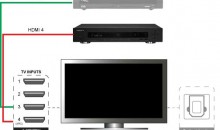Do I Need a 3D Blu-ray Player?
With all of the fuss about 3D, a big question is whether or not to get a 3D Blu-ray player. We’ve got some opinions on this, and have had to adjust some of our thinking based on recent trends. While the push for 3D in the home died out this year (2013), 3D still continues to be a big marketing force in modern electronics like televisions, Blu-ray players and AV receivers.
We just can’t figure out why.
I don’t know anyone who watches 3D Blu-ray movies, though I know plenty of people who watch 3D movies in the theater. In fact, the disparity between the two can only be explained by the fact that 3D is “novel” and people like it that way. In the same way that “cookies are a ‘sometimes’ treat”, 3D movies are not meant for repetitive consumption. In fact, it can damage your eyes if you watch it for too long due to the way that it exercises your eye muscles contrary to how they are supposed to work. Check out this 3D warning from Samsung:
“Children and teenagers may be more susceptible to health issues associated with viewing in 3D and should be closely supervised when viewing these images.”
And this warning from Sony:
“The vision of young children (especially those under six years old) is still under development. SCEA recommends that you consult your doctor (such as a pediatrician or eye doctor) before allowing young children to watch 3D video images or play stereoscopic 3D games. Adults should supervise young children to ensure they follow the recommendations listed above.”
In any case, what goes against the common wisdom is the sheer volume of 3D titles in the Blu-ray market. It’s swarming with 3D titles—and it doesn’t have any indication that it’s going to slow up. On the blu-ray.com website there are currently 393 titles available for purchase, including most of the newest releases. Add to that the fact that the entire hardware market is pretty much 3D-compatible and you’ve got a recipe for 3D consumption.
Except that people simply aren’t watching 3D at home—at least, not n the levels commensurate with the amount of available hardware.
Nearly All New Products are 3D-Compatible
Since the industry went though a complete overhaul with respect to 3D in 2011 through 2013, it’s actually difficult to find a current-generation television, Blu-ray player or AV receiver that doesn’t support it. Some basic TV models forsake 3D, but for the most part, it’s become somewhat universal. With that in mind, if you’re shopping for a new electronics component we don’t think you need to worry much about whether or not it supports 3D—excepting that if it doesn’t you may be buying an outdated model. In addition, 3D technology carries with it compatibility with other updated technologies, like some of the latest HDMI developments in resolution capability, networking support and audio return channel (ARC).
Conclusion
As we stated above, if you’re upgrading your gear, it’s very likely that you’ll get 3D capabilities whether you want them or not. If you do want 3D, by all means make sure that your television and all components support it, but our experience has been that 3D viewing is not all that common in the home and it’s not an enjoyable experience for long-term viewing due to the active 3D technology’s effects on the eye muscles over extended periods of time. If you already have a home theater system, there are plenty of reasons to upgrade your components—but 3D capability isn’t one of them. Recent advances in HDMI means that you can now send audio back from your television to your AV receiver (this feature is called audio return channel, or ARC). Also, networking is supported over HDMI on some modern TVs and AV receivers, so that’s one less cable that needs to be run to connect your equipment.
Did you upgrade to 3D-compatible products? If so, how often do you use 3D? Let us know on Facebook or comment below and join in the discussion.






